sensor AUDI S3 SEDAN 2018 Owner's Guide
[x] Cancel search | Manufacturer: AUDI, Model Year: 2018, Model line: S3 SEDAN, Model: AUDI S3 SEDAN 2018Pages: 404, PDF Size: 62.3 MB
Page 290 of 404

Airbag syste m
can be used with properly insta lled child re
straints. Please be sure to read the important in
formation and warnings whenever using a child
restraint in a veh icle: Safety belts
c> page 260,
Airbag system c> page 269, Ch ild safety
c> page294 .
The s ide ai rb ag sy stem basic ally con sists of:
- the e lectron ic co ntrol mod ule and externa l side
impact sensors
- th e two airbags loca ted in t he sides of t he front
backrests and the two airbags* located in the
rear back rest
- th e a irbag wa rn ing light in the inst rument cl us-
ter.
The a irbag system is monito red elect ronically to
make certa in that it is funct ioning prope rly at all
t imes. Ea ch time you sw itch on the ign ition, the
airbag system indicato r light will come on for a
few seconds (self diagnostics) .
The s ide a irba g system supplements the safety
be lts and can help to reduce the risk of injury to
the dr iver's, front and rear* passenger 's upper
torso on the side of the vehicle t hat is struck in a
side co llision . The airbag dep loys only in side im
pacts and on ly when the ve hicle acceleration reg
is tered by the control unit is h igh enough . If this
rate is below the reference value programmed in
to the control un it, the s ide a irbags w ill not be
tr iggered , even thoug h the ca r may be bad ly
damaged as a result of the collision. It is not pos
sib le to define an a irbag tr igger ing range that
will cover every possib le ang le of impact , since
the circumstances wi ll vary considerably between
one co llision and another. Important factors in
clude, for example, the nature (hard or soft) of
the impacting object, the angle of impact, vehicle
speed , etc.
c> page 289, Important safety in
structions on the side airbag system .
Aside from their normal safety function, safety
be lts work to help keep the driver or front p as
senger in pos it ion in the event of a s ide collision
so that the side a irbags can provide protection .
The airbag system is
not a subst itute for your
safety belt. Rather, it is part of the overa ll occu
pant restraint sys tem in your vehicle . Always re
member that the s ide airbag system can only
288
help to protect you if you are wear ing you r safety
belt and wearing it properly. This is another rea
son why you should a lways wear your safety
belts, not just because the law requires you to do
so c> page 260, General no tes.
It is important to remember that w hile the sup
plementa l side airbag system is designed to re
duce the likelihood of ser ious injuries, other in ju
ries, for example, swelling, bru is ing, friction
burns and m inor abras ions can also be assoc iated
with deployed side airbags . Remember too, s ide
a irbags w ill dep loy only once and only in certa in
ki nds of acc idents
-you r safety belts are a lways
t h ere to offer p rotect ion.
Vehicle damage, repair costs or even the lack of
vehicle damage are not necessar ily an ind ication
of over-se nsit ive or fa iled a irbag act ivat ion. In
some coll is ions, bo th front and side airbags may
i nflate. Remember too, tha t airbags w ill dep loy
on ly once and on ly in certain kinds of collisions
-
your safety be lts are always there to offer protec
tion in those accidents in which ai rbags are not
supposed to deploy or when they have already
deployed .
The side airbag system will n ot deplo y:
-when t he ignition is switched off
- in side co llisions when the a ccelera tion meas -
ured by the sensor is too low
- in fro nt-end coll is io ns
- in rea r-end co llisions
- in rollovers .
In some types of accidents the front airbags, side
curtain airbags and side a irbags may be triggered
together .
A WARNING
-Safety belts and the airbag system will only
provide protect ion when occupants are i n
the prope r sea ting pos it ion
c> page 289.
- If t he a irbag ind icator light c> page 26
comes w hen the veh icle is being used, have
the system inspe cted immedia tely by your
author ized A udi dealer. It is poss ib le that
the airbag will in flate when i t is not sup
posed to, or wi ll not inflate when it should .
Page 292 of 404

Airbag system
-Damage to the original seat covers or to
the seam in the area of the side airbag module must always be repaired immedi
ately by an authorized Audi dealer .
- Objects between you and the airbag can in
crease the risk of injury in an accident by in
terfering with the way the airbag unfolds or by being pushed into you as the a irbag in
flates.
- Never place or attach accessories or other
objects (such as cup holders, telephone
brackets, or even large, bulky objects) on
the doors, over or near the area marked
"AIRBAG" on the seat backrests .
- Such objects and accessories can become
dangerous projectiles and cause injury
when the supplemental s ide airbag de
ploys.
- Never carry any objects or pets in the de
ployment space between them and the
airbags or allow chi ldren or other passen
gers to travel in this posit ion.
- Always use the built-in coat hooks only for
lightweight clothing . Never leave any heavy
or sharp-edged objects in the pockets that
may interfere with side airbag deployment
and can cause personal injury in an accident .
- Always prevent the side airbags from being
damaged by heavy objects knocking against
or hitting the sides of the seatbacks.
- T he airbag system can only be triggered
once .
If the airbag has been triggered, the
system must be replaced by an authorized
Audi dealership.
- Damage (cracks, deep scratches etc.) to the
original seat covers or to the seam in the
area of the side airbag modu le must always
be repaired immediately by an authorized
Audi dealer.
-If children are seated improper ly, their risk
of injury increases in the case of an acc ident
¢ page 2 94, Child safety.
-Never attempt to modify any components of
the a irbag system in any way.
-In a side collision, side airbags w ill not func
t ion properly if sensors cannot correctly
measure increasing air pressure inside the
290
doors when air escapes through larger, un
closed openings in the door panel.
- Never drive with inte rior door trim panels
r emoved.
- Never dr ive when parts have been re
moved from the inside door panel and the
openings they leave have not been proper
l y closed.
- Never drive when loudspeakers in the
doors have been removed unless the
speaker holes have been properly closed.
- Always make certain that openings are
cove red or filled if additional speakers or
other equipment is installed in the inside
door panels .
- Always have work on the doors done by an
authorized Aud i dealer or qualified work
shop .
Side curtain airbags
Description of side curtain airbags
Applies to: vehicles with side curtain airbags
The side curtain airbag sys tem can provide sup
plemental protection to properly restrained oc
cupants .
Fig. 24S Sid e curt ain air b ags , driver's s ide: s ide curt ain air
bag location (example)
The side curtain airbags are located on both sides
of the inter ior above the front and rear side win
dows ¢
fig. 245. They are identified by the word
"A IRBAG" on the windshie ld frame and the cen
ter roof pillar.
The side curtain airbags contain features that
provide ejection mitigation to help prevent vehi-
cle occupants or parts of their bodies from being completely or partia lly ejected from the vehicle
II>
Page 293 of 404
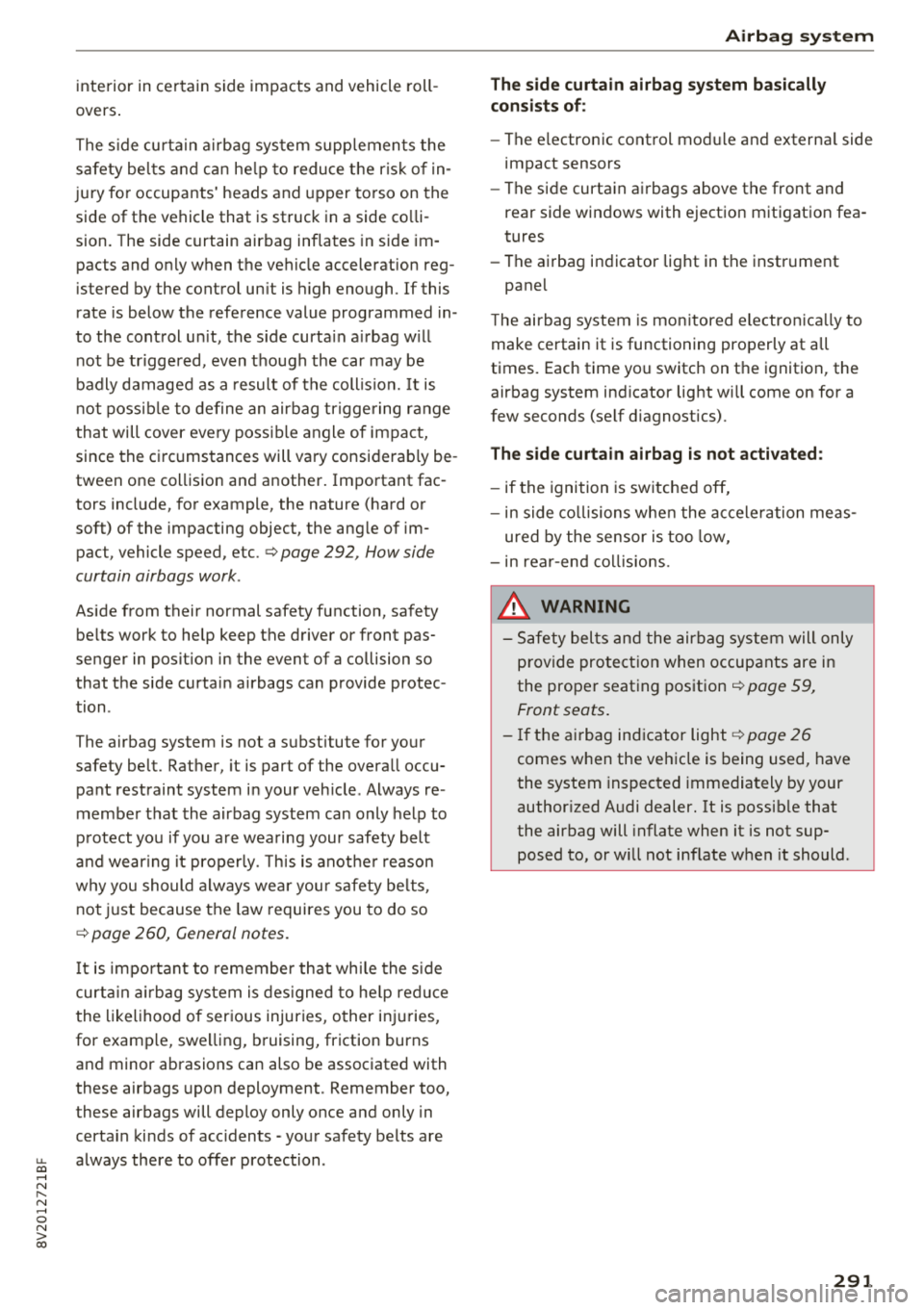
interior in certain side impacts and vehicle roll
overs .
The s ide curta in a irbag system supplements the
safety be lts and can he lp to reduce t he r isk of in
jury for occupants' heads and upper torso on the
side of th e vehicle that is struck in a side co lli
sion. The side curtain airbag inflates in side im
pacts and only when the vehicle acceleration reg
is tered by the control un it is h igh enough . If this
rate is below the reference value programmed in
to the control un it, the s ide curta in a irbag w ill
not be tr iggered, even though the car may be
badly damaged as a result of the collis ion. It is
not poss ib le to define an airbag tr iggering r ange
that will cover every poss ible angle of impa ct,
since the circumstances will vary considerab ly be
tween one collision and another. Important fac
tors include , for example, the nature (hard or
soft) of the impacting object, the ang le of im
pact, vehicle speed, etc .
¢ page 292, How side
curtain airbags work .
Aside from their no rmal safety function, safety
be lts work to help keep the driver or front pas
senger in posit ion in the event of a collision so
that the side curtain airbags can provide protec
tion .
The airbag system is not a subst itute for your
safety belt. Rather, it is part of the overall occu
pant restraint system in your veh icle . Always re
membe r that the airbag system can only help to
p rotect you if you a re wea ring your safety belt
and wear ing it properly . T his is anot he r r eason
why you should always wea r your safety be lts,
not just because the law requires you to do so
¢ page 260, General notes.
It is important to remember that wh ile the s ide
curta in a irbag system is des igned to he lp red uce
the likelihood of ser ious injuries, other inj uries,
for example, swe lling, bruising, friction burns
and minor abrasions can also be associated with
these airbags upon deployment . Remember too,
these airbags will deploy only once and only in
certa in kinds of acc idents
-your safety belts are
::li always there to offer protection .
.-< N l' N .-< 0 N > 00
Airbag syste m
The side curtain airbag sy ste m basically
consists of :
-The e lectronic control module and externa l side
impact sensors
- The side curtain airbags above the front and
rear side windows with ejection mitigation fea
tures
- The airbag indicator lig ht in the instrument
pane l
T he airbag system is mon itored e lectro nica lly to
make certain it is functioning properly at a ll
times. Each time you switch on t he ignition, the
airbag system ind icato r light will come on for a
few seconds (se lf d iagnostics) .
The side curtain airbag is not activated:
-if the ignition is sw itched off,
- in side co llisions whe n the ac cele ration meas-
ured by the sensor is too low,
- in rea r-end co llisions.
_&. WARNING
- Safety bel ts an d the airbag system will only
p rovide protect io n when occupants are in
the proper seating position
¢ page 59,
Front seats.
- If th e ai rbag ind icator light ¢ page 26
comes when the vehicle is being used, have
the system inspected immediately by your
author ized Audi dealer.
It is possib le that
the airbag will inflate when it is not sup
posed to, or w ill not inflate w hen it should .
291
Page 350 of 404
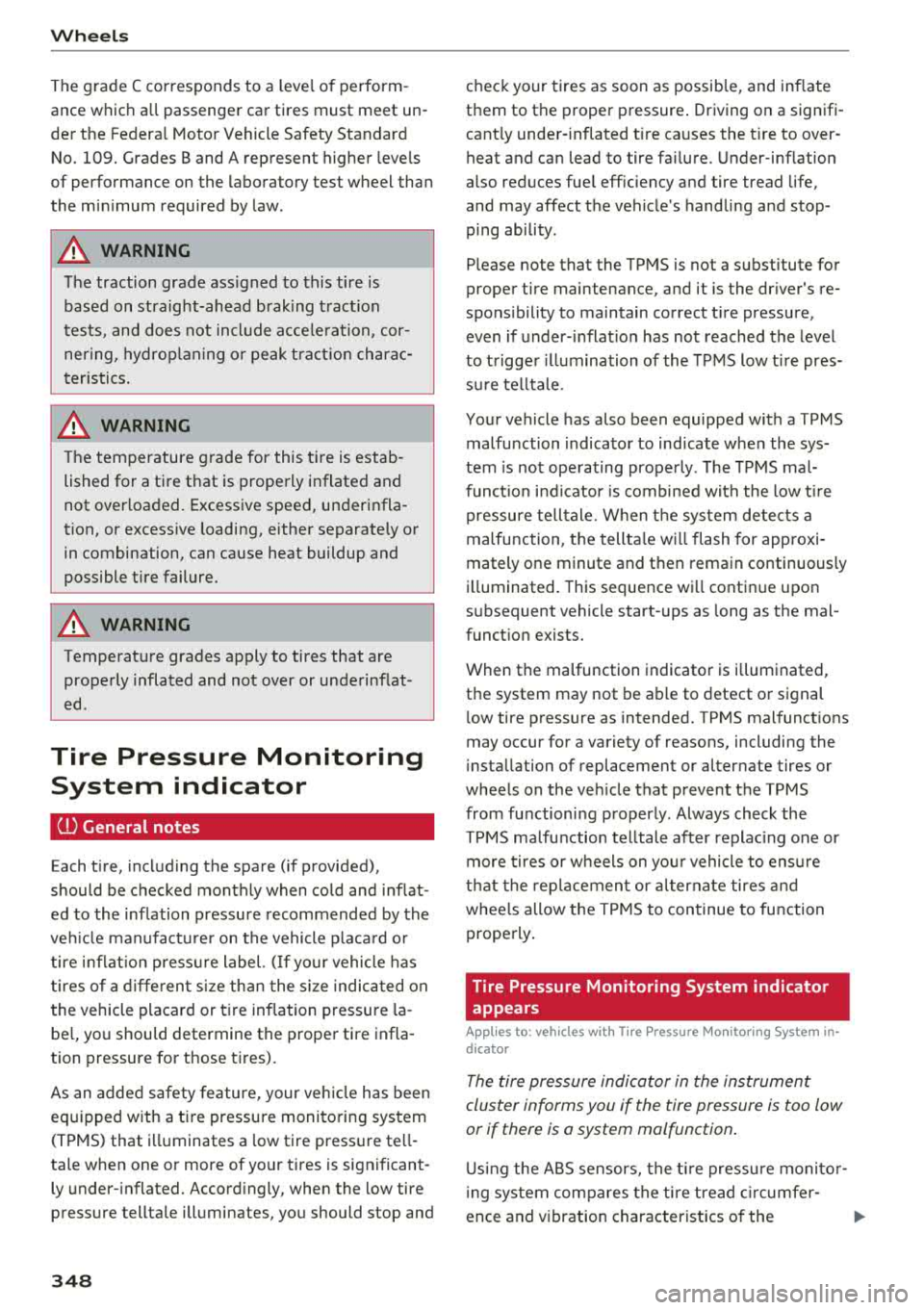
Wheels
The grade C corresponds to a leve l of perform
ance which all passenger car tires must meet un
der the Federa l Motor Vehicle Safety Standard
No.
109. Grades Band A represent higher levels
of performance on the laboratory test wheel than
the minimum required by law.
A WARNING -
The traction grade ass igned to this tire is
based on straight-ahead braking traction
tests, and does not include acce le rat ion, cor
ne ring, hydroplaning or peak traction charac
teristics.
A WARNING
Th e temperatu re grade for this tire is estab
lished for a tire that is properly inflated and
not overloaded. Excessive speed, underinfla
tion, or excessive loading, either separate ly or
in combination, can cause heat buildup and
possible tire failure.
A WARNING
-
-
Temperature grades apply to tires that are properly inflated and not over or underinflat
ed.
Tire Pressure Monitoring System indicator
(J.) General notes
Each t ire, including the spare (if provided),
should be checked monthly when cold and inflat
ed to the inflation pressure recommended by the
ve hicl e manufacturer on the vehicle placard or
tire in flat ion press ure label. ( If yo ur vehicle has
t ires of a different siz e than the size indicated on
the vehicle placard or tire inflation pressure la
be l, you should determine the proper tire infla
tion pressure for those t ires) .
As an added safety feature, your veh icle has been
equipped with a tire pressure monitoring system
(TPMS) that illuminates a low tire pressure te ll
tale when one or more of your t ires is significant
ly under-inflated. Accordingly, when the low tire
pressure tellta le illuminates, you should stop and
348
check your tires as soon as possible, and inflate
them to the proper pressure . Driving on a signifi
cant ly under-inflated t ire causes the t ire to over
heat and can lead to tire fa ilure . Under-inflation
also reduces fue l eff iciency and tire tread life,
and may affect the vehicle's handling and stop
ping ability .
Please note that the TPMS is not a substitute for
proper tire maintenance, and it is the dr iver's re
spons ibility to maintain correct tire pressure,
even if under-inflation has not reached the level
to trigger illumination of the TPMS low tire pres
su re te lltale.
Your vehicle has also been equipped with a TPMS
malfunction indicator to indicate when the sys
tem is not operating prope rly . The TPM S mal
function indicator is combined with the low tire
pressure telltale. When the system detects a
malfunction, the telltale will flash for approxi
mately one minute and then remain continuously
illuminated. This sequence wi ll continue upon
s ub sequent vehicle start-ups as long as the mal
funct ion exists.
When the malfunction indicator is illuminated,
the system may not be able to detect or signal
l ow tire pressure as intended. TPMS malfunctions
may occur for a variety of reasons, including the
i nstallation of replacement or alternate tires or
wheels on the veh icle that prevent the TPMS
from functioning properly. Always check the
TPMS ma lfunction telltale after replac ing one or
more tires or wheels on you r vehicle to ens ure
that the rep lacement or alternate tires and
whee ls allow the TPMS to continue to function
properly.
Tire Pressure Monitoring System indicator
appears
App lies to : vehicles wit h Tire Pressure Mo nitor ing System in
dicator
The tire pressure indicator in the instrument
cluster informs you if the tire pressure is too low
or if there is a system malfunction .
Using the ABS sensors, the tire pressure monitor
in g system compares the tire tread circumfer
en ce and vibration characteristics of the
Page 352 of 404
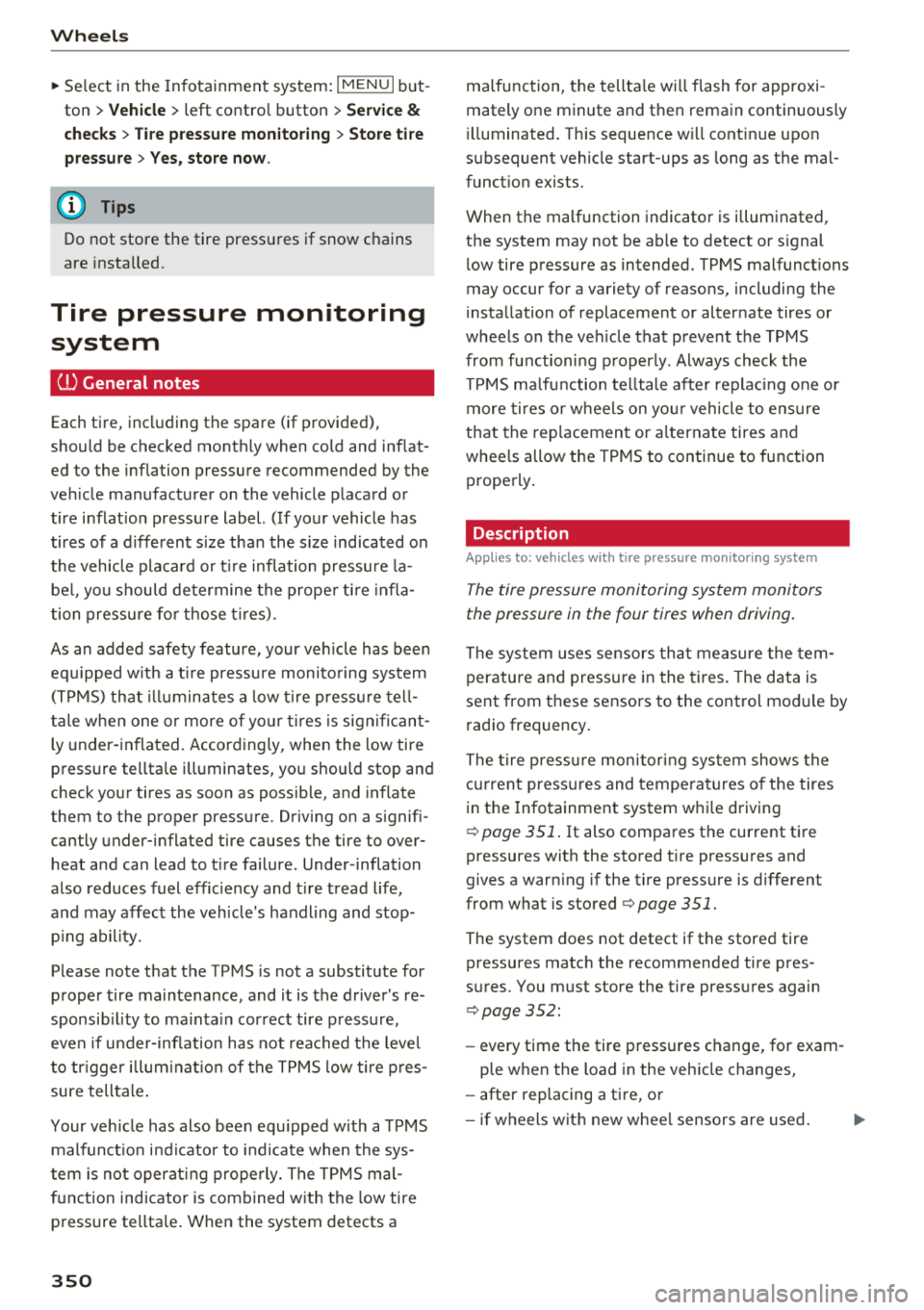
Wheels
~ Select in the Infotainment system: IMENUI but
ton
> Vehicle > left control button > Service &
checks > Tire pressure monitoring > Store tire
pressure> Yes, store now.
(D Tips
Do not store the tire pressures if snow chains
are installed.
Tire pressure monitoring
system
(.L) General notes
Each tire, including the spare (if provided),
should be checked monthly when cold and inflat
ed to the inflation pressure recommended by the
vehicle manufacturer on the vehicle placard or
tire inflation pressure label. (If your vehicle has
tires of a different size than the size indicated on
the vehicle placard or t ire inflation pressure la
bel, you should determine the proper tire infla
tion pressure for those tires).
As an added safety feature, your vehicle has been
equ ipped w ith a t ire pressure monitoring system
(TPMS) that illuminates a low tire pressure tell
tale when one or more of your tires is significant
ly under-inflated. Accordingly, when the low tire
pressure telltale illuminates, you should stop and
check your tires as soon as possible, and inflate
them to the proper pressure. Driving on a signifi
cantly under-inflated tire causes the tire to over heat and can lead to tire failure . Under -inflation
also reduces fuel efficiency and tire tread life,
and may affect the vehicle's handling and stop
p in g ability.
Please note that the TPMS is not a substitute for
proper tire maintenance, and it is the driver's re
sponsibility to maintain correct tire pressure,
even if under-inflation has not reached the leve l
to trigger illuminat ion of the TPMS low tire pres
sure telltale .
Your vehicle has also been equipped with a TPMS
malfunct ion indicator to indicate when the sys
tem is not operating properly. The TPMS mal
function indicator is combined with the low tire
pressure telltale. When the system detects a
350
malfunction, the telltale will flash for approxi
mately one minute and then remain continuously
illuminated. This sequence will continue upon
subsequent vehicle start-ups as long as the mal
function exists.
When the malfunction indicator is illuminated,
the system may not be able to detect or signal
low tire pressure as intended. TPMS malfunctions
may occur for a variety of reasons, including the
installation of replacement or alternate tires or
wheels on the vehicle that prevent the TPMS
from functioning properly. Always check the
TPMS malfunction tel ltale after replac ing one or
more tires or wheels on your vehicle to ensure
that the replacement or alternate tires and
wheels allow the TPMS to continue to function
properly.
Description
Applies to: vehicles with tire pressure monitoring system
The tire pressure monitoring system monitors
the pressure in the four tires when driving.
The system uses sensors that measure the tema
perature and pressure in the tires. The data is
sent from these sensors to the control module by
radio frequency .
The tire pressure monitoring system shows the
current pressures and temperatures of the tires
in the Infotainment system while driving
¢ page 351. It also compares the current tire
pressures with the stored tire pressures and
gives a warning if the tire pressure is different
from what is stored
¢ page 351.
The system does not detect if the stored tire
pressures match the recommended tire pres
sures . You must store the tire pressures again
¢ page 352:
- every time the tire pressures change, for exam
ple when the load in the vehicle changes,
- after replacing a tire, or
- if wheels with new wheel sensors are used.
Page 353 of 404
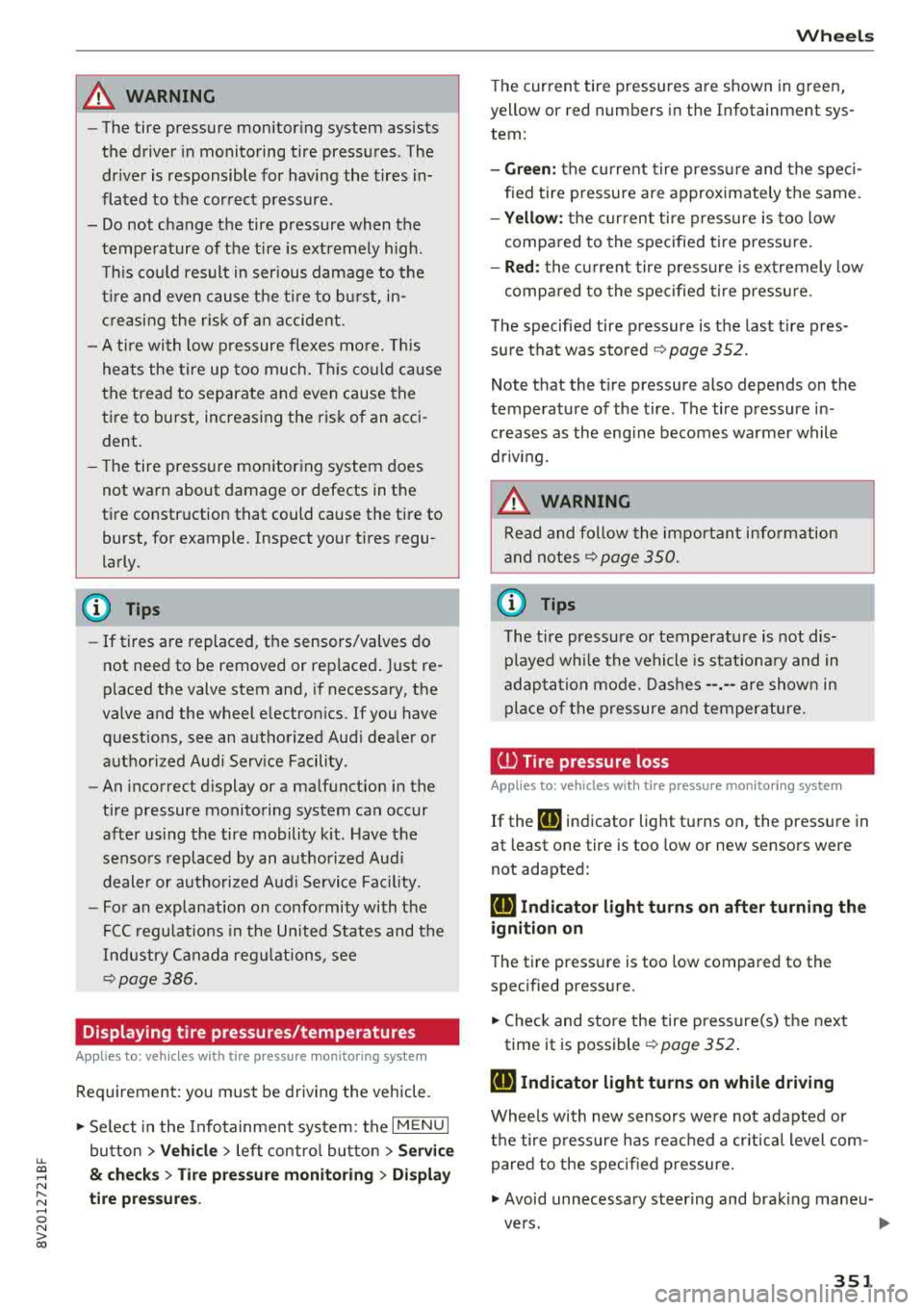
u. 00 .-< N l' N .-< 0 N > 00
A WARNING
-The tire pressure monitoring system assists
the driver in monitoring tire pressures . The
driver is responsible for having the tires in
flated to the correct pressure.
- Do not change the tire pressure when the
temperature of the tire is extremely high.
This could result in serious damage to the
tire and even cause the tire to burst, in
creasing the risk of an accident.
- A tire with low pressure flexes more. This
heats the tire up too much. This could cause
the tread to separate and even cause the
tire to burst, increasing the risk of an acci
dent.
- The tire pressure monitoring system does
not warn about damage or defects in the
tire construction that could cause the tire to burst, for example . Inspect your tires regu
larly .
(D Tips
-If tires are replaced, the sensors/valves do
not need to be removed or replaced. Just re
placed the valve stem and, if necessary, the
valve and the wheel electronics. If you have
questions, see an authorized Audi dealer or
authorized Audi Service Facility .
- An incorrect display or a malfunction in the
tire pressure monitoring system can occur
after using the tire mobility kit . Have the
sensors replaced by an authorized Audi
dealer or authorized Audi Service Facility.
- For an explanation on conformity with the
FCC regulations in the United States and the
Industry Canada regulations, see
r=;,page 386.
Displaying tire pressures/temperatures
Applies to: vehicles with tire pressure mo nito ring system
Requirement: you must be driving the vehicle.
"'Select in the Infotainment system: the I MENU I
button > Vehicle > left control button > Service
& checks > Tire pressure monitoring > Display
tire pressures.
Wheels
The current tire pressures are shown in green,
yellow or red numbers in the Infotainment sys
tem:
- Green: the current tire pressure and the speci
fied tire pressure are approximately the same.
- Yellow: the current tire pressure is too low
compared to the specified tire pressure.
-Red: the current tire pressure is extremely low
compared to the specified tire pressure .
The specified tire pressure is the last tire pres
sure that was stored
r=;, page 352.
Note that the tire pressure also depends on the
temperature of the tire. The tire pressure in
creases as the engine becomes warmer while
driving.
A WARNING
Read and follow the important information
and notes
"*page 350.
(D Tips
The tire pressure or temperature is not dis
played while the vehicle is stationary and in
adaptation mode. Dashes--.-- are shown in
place of the pressure and temperature.
ill Tire pressure loss
Applies to: vehicles with tire press ure mo nito ring system
-
If the [tE indicator light turns on, the pressure in
at least one tire is too low or new sensors were
not adapted:
RE Indicator light turns on after turning the
ignition on
The tire pressure is too low compared to the
specified pressure .
.,. Check and store the tire pressure(s) the next
time it is possible
"*page 352.
RE Indicator light turns on while driving
Wheels with new sensors were not adapted or
the tire pressure has reached a critical level com
pared to the specified pressure.
"'Avoid unnecessary steering and braking maneu-
vers.
..,_
351
Page 354 of 404

Wheels
~ Adapt your driving style to the situation.
~ Stop as soon as possible and check the tire(s) .
~ If it is possible to continue driving, see an au-
thorized Audi dea ler or authorized Audi Service
Facility immediately and have your tire(s) re
paired or replaced.
A WARNING
Read and follow the important information
and
notes ~ page 350.
Storing new tire pressures
App lies to: ve hicles w ith tire press ure m on itoring system
Correctly stored tire pressure specifications are
necessary for reliable tire pressure monitoring.
-
It is always necessary to store the tire pressures
when the tire pressures are modified, for exam ple due to a change in load. or when new sensors
are installed .
~ Before storing the tire pressures, make sure the
tire pressures of all four tires meet the speci
fied values and are adapted to the load
~ page 341, fig . 2 78 . Only correct and store
the pressure in tires whose temperature is ap
prox imat ely the same as the ambient tempera
ture .
If the temperature of the tire is higher
than the ambient air temperature, the tire
pressure must be increased approximate ly
3 .0 PSI (0 .2 bar) above the va lue on the sticker .
~ Switch the ignition on.
~ Select in the Infotainment system: IMENUI but
ton
> Vehicle > left control button > Service &
checks > Tire pressure monitoring > Store tire
pressure > Yes, store now .
After storing the
tire pressu res, the t ire pressu re monitoring sys
tem measures the current pressures wh ile driv
in g and stores them as the new specified pres
sures.
~ If the changed tire pressures are not displayed
in the Infotainment system, drive the vehicle
for approximate ly 10 minutes so that the sen
sor signal from the wheels is received again.
During this adaptation phase, --.-- is displayed
for the pressure and temperature and the tire
pressure mon itor ing system is only partially
ava ilable. It only provides a warning if one or
352 more
tire pressures is below the minimum per
mitted specified pressure.
If the
[I] ind icator light turns on and the mes
sage
Tire pressure : wheel change detected .
Please check all tires and store pressures in
MMI also appears, the system has detected that
the position of the sensors has changed because
of a tire rotation, or that new sensors were in
stalled. Store the new tire pressures.
A WARNING
Read and follow the important information
and notes
~pag e 350.
Malfunctions
Applies to: vehicles with t ire pressure mo nitori ng syste m
If the tire pressure monitoring system is not
available, t he
mm in dicator light appears in the
instr umen t cluste r display along with the mes
sage
Tire pressure : malfun ction! See owner's
manual.
-
If the ffim ind icator light appears after switch
in g the ignitio n on or wh ile dr iving and the
[IJ in
dicator light also blinks for approximately one
minute and then stays on, there is a system ma l
function . The fo llowing are examples of situa
tions that could cause a malfunction:
- If the message appears at the end of the adap
tation phase, the system may not detect one or
several of the whee l sensors necessary for pres
sure monitoring. This may res ult from one or
more whee ls being installed without wheel sen
sors or with incompatible wheel sensors.
- A wheel sensor or another component has
fa iled.
- Using snow chains can affect the function of
the system because of the shielding effect of
the chains.
- The tire pressure monitoring system is not
avai lab le due to a ma lfunction.
- Transmitters with the same frequency, such as
headphones or remote-controlled devices, may
cause a temporary system malfunct ion due to
the strong electromagnetic field.
.,.
Page 357 of 404

u. 00 .-< N l' N .-< 0 N > 00
Apply the product using a mic rofiber cloth. To
avoid damaging the paint surface, do not use too
much pressure .
R inse the veh icle t horo u ghly wi th wa ter. Then
clean using a neutra l shampoo and a soft micro
fiber cloth.
R inse the veh icle t horo u ghly again and let it a ir
d ry . Remove any water res idue using a ch amois.
A WARNING
-Only wash the vehicle when the ignition is
off and follow the instructions from the car
wash operator to reduce the risk of acci dents.
-T o reduce the risk of cuts, protect yourself
from sharp metal components when wash ing the underbody or the inside of the wheel
hous ings .
-After wash ing the vehicle, the brak ing effect
may be de layed due to mo isture on the
brake rotors or ice in the w inter . This in
c reases the risk of an acc ident. The brakes
must be d ried fi rst w it h a few careful b rake
app lications.
@ Note
-If you wash t he veh icle in an automatic car
wash, you m ust fold the exterior m irrors in
-
Care and cleaning
to reduce the r isk o f damage to the m irro rs .
Power fo lding exterior mirrors* m ust only
be folded in and o ut using the power fold ing
function.
-T o red uce the risk of paint damage, do not
was h the vehicle in direct s unlight.
-T o red uce the risk of damage, do not was h
the power top * w ith a pressu re washe r.
-T o red uce the risk of damage to the s urface,
do not use insect removing sponges, kitche n
sponges or s imilar items.
-Matte finish painted vehicle components:
-To reduce t he risk of damage to t he sur-
face, do not use pol ish ing agents or hard
wax.
-Neve r use protective wax. It can destroy
the matte finish effect .
-Do not place any st ickers or magnetic
s igns on vehicle parts painted with matte
finish paint. The paint cou ld be damaged
when the stickers or magnets a re re
moved.
@ For the sake of the environment
Only wash the veh icle in facilities spec ia lly de
s igned for that pu rpose. This will reduce the
r isk of di rty wate r contam ina ted with o il from
en te ring the sewe r sys tem.
Cleaning and care information
When clea ning and caring for individua l vehicle
components, refer to the follow ing tables . The
in fo rmat ion conta ined there is s imp ly recom
mendations . Fo r qu est io ns or for components t
h at are not listed, consult an authorized Aud i
dealer or authorized Audi Service Fac il ity. Also
fo llow the information found
in c:> ,& .
Exterior cleaning
Component Situation
Solution
Wind shield wip er
Deposits soft cloth wi th glass cleane r, ~ page 56
blade s
Headlights /
Deposits Soft sponge with a mild soap solutiona)
Tail light s
Sensors /
Deposits Sensors: soft cloth wit
h solvent -free cleaning solution
camera lenses Camera lenses: soft cloth with a lcohol-free cleaning so lu-
tion
Snow/ice Hand br ush/solven t-free de-icing spray
355
Page 374 of 404
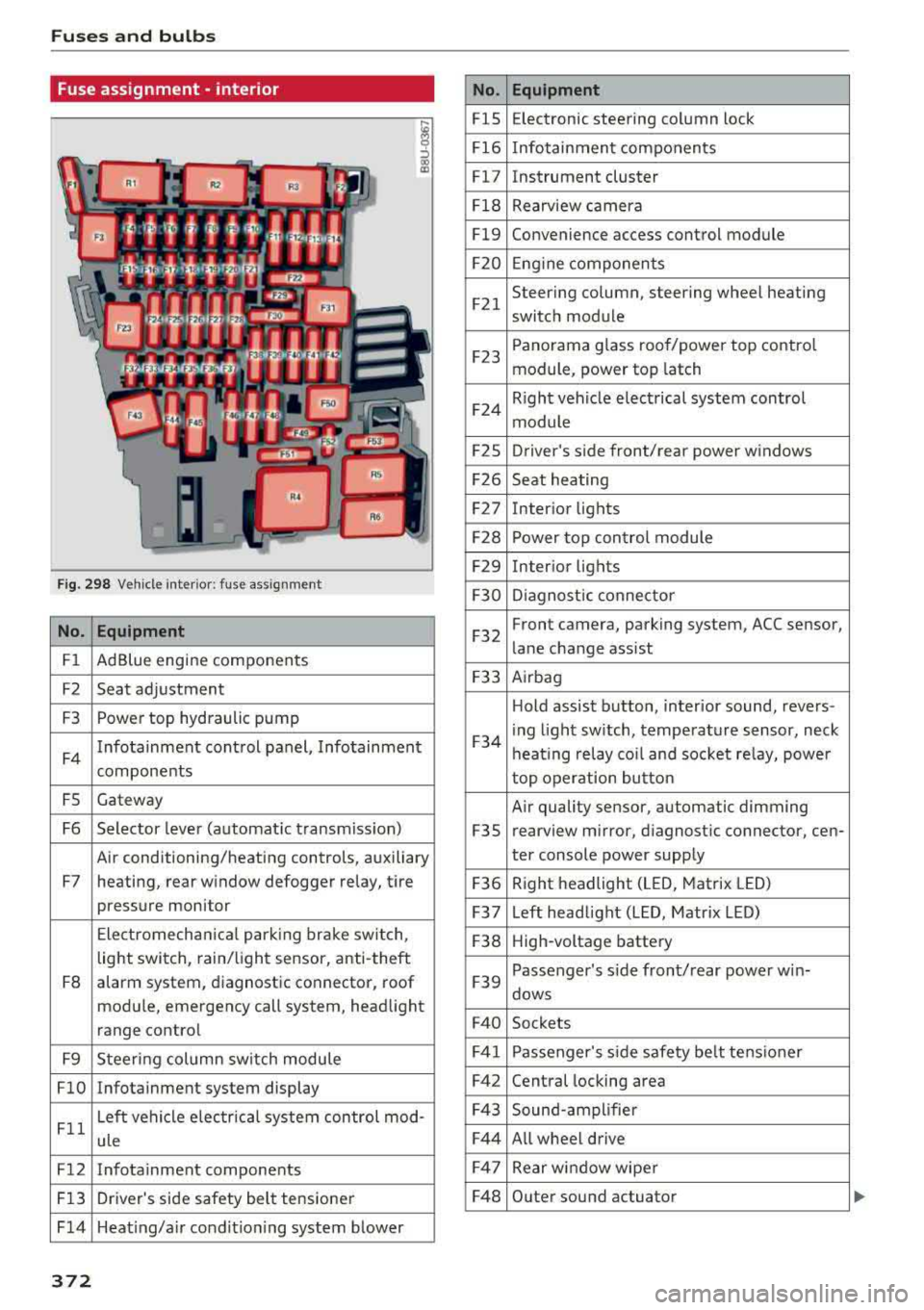
Fuses and bulbs
Fuse ass ignment - interior
ij
::, CX) ID
F ig. 298 Vehicle interior: fuse assignment
No. Equipment
Fl Ad Blue engine components
F2 Seat adjustment
F3 Power top hydraulic pump
F4 Infotainment control panel,
Infotainment
components
FS Gateway
F6 Selector lever (automat ic transm iss ion)
Air conditioning/heating controls, auxiliary
F7 heating, rear window defogger relay, tire pressure monitor
Electromechan ical park ing brake switch,
light switch, rain/light sensor, anti-theft
F8 alarm system,
diagnostic connector, roof
module, emergency call system, head light
range control
F9 Steering col umn sw itch module
FlO Infotainment system display
Fll Left vehicle electrica
l system control mod-
ule
F12 Infotainment components
F13 Driver's side safety belt tensioner
F 14 Heat ing/a ir condit ion ing system blower
372
No . Equipment
FlS Electronic
steering column lock
F16 Infotainment components
Fl7 Instrument cluster
Fl8 Rearview camera
Fl9 Convenience access control module
F20 Engine components
F21 Steering column, steering wheel heating
switch module
F23 Panorama glass
roof/power top control
module, power top latch
F24 R
ight vehicle electrical system control
module
F2S Driver
's side front/rear power windows
F26 Seat heating
F27 Interior
lights
F28 Power top control module
F29 Interior lights
F30 Diagnostic connector
F32 Front camera, parking
system, ACC sensor,
lane change assist
F33 Airbag
Hold assist button, interior sound, revers-
F34 i
ng light sw itch, temperature sensor, neck
heating relay coil and socket relay, power
top operation button
Air quality sensor, automatic dimming
F3S rearview
mirror, diagnostic connector, cen-
ter console power supply
F36 Right
headlight (LED, Matrix LED)
F37 Left headlight (LED, Matrix LED)
F38 High-voltage battery
F39 Passenger
's side front/rear power w in-
dows
F40 Sockets
F41 Passenger's sid e safe ty be lt tens ioner
F42 Central locking area
F43 Sound-amplifier
F44 All wheel drive
F47 Rear window wiper
F48 Outer sound actuator
Page 375 of 404
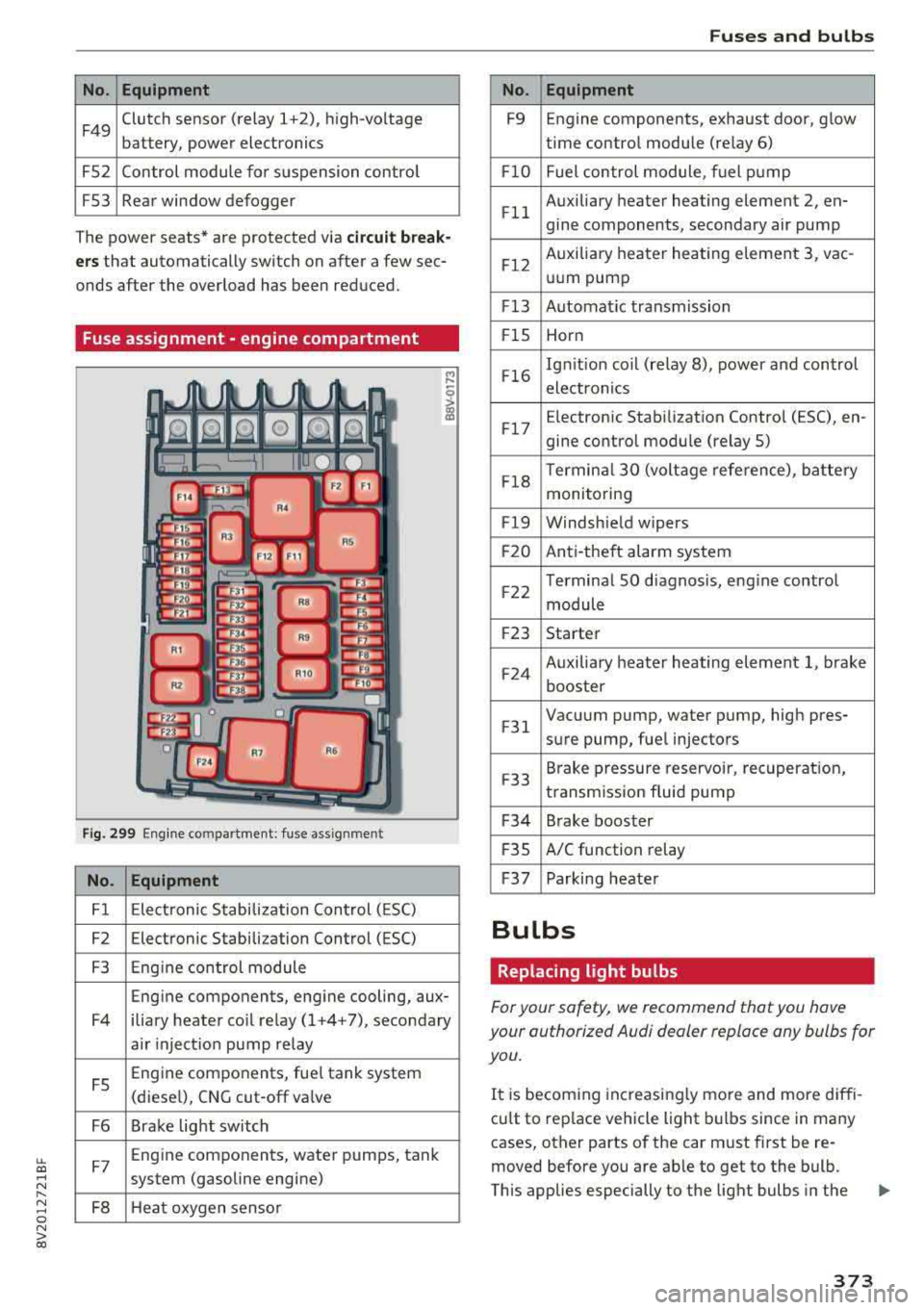
LL co .... N
" N .... 0 N > co
No. Equipment
F49 Clutch sensor (relay 1+2),
high-voltage
battery, power electronics
F52 Control module for suspension control
F53 Rear window defogger
The power seats* are protected via
circuit break
ers
that automatically switch on after a few sec
onds after the overload has been reduced.
Fuse assignment -engine compartment
Fig. 299 Engine compartme nt: fuse assignment
No. Equipment
Fl Electronic Stabilization Control (ESC)
F2 Electronic Stabilization Control (ESC)
F3 Engine control module
Eng ine components, engine cooling, aux-
F4 iliary heater co il relay (1+4+7), secondary
air inject ion pump relay
FS Engine components, fue
l tank system
(diesel), CNG cut-off va lve
F6 Brake light switch
F7 Eng
ine components, water pumps, tank
system (gasoline engine)
FB Heat oxygen sensor
Fuses and bulbs
No. Equipment
F9 Engine
components, exhaust door, glow
time control module (relay 6)
F lO Fuel control module, fuel pump
F ll Auxiliary
heater heating element 2, en-
gine components, secondary air pump
F12 Auxiliary
heater heating element 3, vac-
uum pump
F13 Automat ic transmission
F lS Horn
F16 Ign
it ion coil (relay 8), power and control
electronics
F17 E
lectroni c Stabilization Control (ESC), en-
gine control module (relay S)
F18 Terminal
30 (voltage reference), battery
monitoring
Fl9 Windshield wipers
F20 Anti-theft alarm system
F22 Terminal
SO diagnos is, engine control
module
F23 Starter
F24 Auxiliary
heater heating element 1, brake
booster
F 31 Vacuum pump, water pump, high pres-
sure pump, fuel injectors
F33 Brake
pressure reservoir, recuperation,
transmission fluid pump
F34 Brake booster
F 35 A/C function
relay
F37 Parking heater
Bulbs
Replacing light bulbs
For your safety, we recommend that you have
your authorized Audi dealer replace any bulbs for
you.
It is becom ing increasingly more and more diffi
cu lt to replace vehicle light bulbs since in many
cases, other parts of the car must first be re
moved before you are ab le to get to the bulb.
This applies especially to the light bulbs in the
373